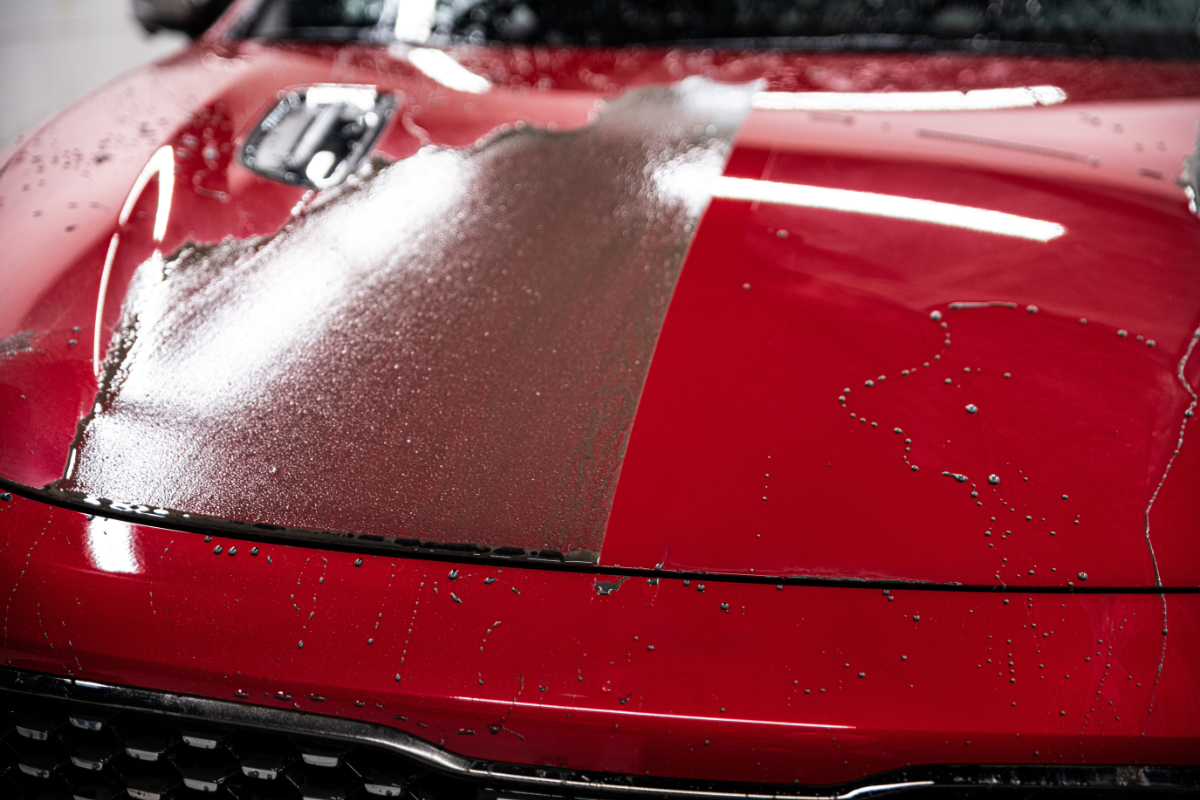Why Ceramic Coating Is the Ultimate Solution for a Remarkable Complete
Ceramic covering has become a leading solution for those looking for a flawless coating for their cars, thanks to its exceptional resilience and safety features. This sophisticated fluid polymer not just bonds perfectly with factory paint yet also uses an awesome obstacle versus common dangers such as scrapes, UV rays, and environmental contaminants. Its hydrophobic residential properties streamline upkeep while improving visual charm. Recognizing how this innovation contrasts to typical techniques and exploring its application subtleties can reveal even more about its value. What elements truly set ceramic coating apart?
What Is Ceramic Covering?

When used correctly, ceramic finishing develops a hydrophobic surface area that wards off water and dirt, making it less complicated to preserve and cleanse. Unlike conventional waxes or sealants, which commonly offer brief defense, ceramic finishings can last for several years, depending upon the item quality and application technique. The process of using ceramic layer needs careful preparation, consisting of thorough cleaning and often repaint improvement, to guarantee optimal bonding and efficiency.
Ceramic finishings are not restricted to auto surfaces; they can likewise be utilized on different materials, consisting of glass, steel, and plastics, offering a versatile option for improving protection. Generally, ceramic covering stands for a significant innovation in surface security technology, combining both aesthetic and useful benefits for a wide variety of applications.
Advantages of Ceramic Finish
While many surface area protection options exist, the benefits of ceramic finishing stand apart because of its unique buildings and resilient performance. One of the primary benefits is its extraordinary durability. Ceramic Coating Philadelphia. Unlike conventional wax or sealers that require frequent reapplication, ceramic layers supply a resistant layer that can last for numerous years, dramatically reducing upkeep efforts
One more notable benefit is boosted defense versus environmental pollutants. Ceramic coatings produce a hydrophobic surface that repels water, dirt, and different contaminants, making it simpler to cleanse. This attribute not only maintains the car's appearance but additionally reduces the risk of corrosion and oxidation, particularly in harsh climate condition.
Additionally, ceramic coatings use superior resistance to UV rays, preventing fading and degradation of paint over time. This UV protection is essential for maintaining the visual worth of surface areas and cars exposed to guide sunlight.
Furthermore, the glossy surface accomplished with ceramic covering boosts the total aesthetic charm, giving surface areas a showroom-quality shine. Overall, ceramic layers represent a substantial development in surface area protection modern technology, supplying long-lasting benefits that provide to both visual and functional demands.
How It Works
Understanding the science behind ceramic layers exposes exactly how they supply such impressive protection and long life. At its core, a ceramic covering is a fluid polymer that chemically bonds with the car's manufacturing facility paint.
The application process includes numerous steps, consisting of surface preparation, which is important to achieving optimal bond. When used, the layer goes through a curing process, throughout which it solidifies and develops a semi-permanent bond with the paint surface area. This bond is what identifies ceramic layers from conventional waxes and sealers, offering a longer-lasting safety barrier that can endure for several years.
Additionally, the thickness of the finish can improve its protective qualities, making certain that it can hold up against extreme problems. Ultimately, the scientific research of ceramic finishings combines innovative materials with cutting-edge application techniques to provide an unequaled level of defense and aesthetic improvement for lorries.
Comparison With Traditional Techniques
The benefits of ceramic coverings become specifically evident when contrasted to conventional paint defense techniques such as waxes and sealants. While waxes supply a momentary he has a good point sparkle, typically lasting a few weeks to a couple of months, ceramic coverings provide a durable safety layer that can sustain for a number of years. This toughness considerably minimizes the regularity of reapplication, making ceramic coverings an extra cost-efficient remedy gradually.
Additionally, conventional methods often need substantial prep work and multiple applications to achieve an acceptable degree of security. In contrast, ceramic finishings bond at a molecular level with the lorry's surface, developing a robust shield against environmental pollutants like UV rays, acid rain, and road salts. This bond improves the lorry's resistance to scrapes and swirl marks, which prevail with conventional waxes and sealers.
In addition, the hydrophobic residential or commercial properties of ceramic coatings fend off water and dirt, resulting in less complicated cleaning and maintenance. On the other hand, wax and sealant-treated surfaces can attract crud, demanding even more frequent washing - Ceramic Coating Philadelphia. Generally, ceramic coverings not just offer superior defense but also deliver a more enduring and visually enticing finish, establishing them as the recommended selection for discerning automobile proprietors
Application and Maintenance Tips

Making use of a foam applicator, apply the covering in little sections, adhering to the maker's guidelines pertaining to density and overlap. Allow sufficient healing time between layers, usually 24 hr, to guarantee proper bonding. After application, it is important to avoid direct exposure to water or harsh elements for at least a week to permit the layer to fully cure.
For maintenance, wash the vehicle routinely with pH-balanced soaps and prevent rough products. Touchless auto cleans are recommended to lessen scraping. Furthermore, making use of a ceramic maintenance spray can improve the coating's hydrophobic residential properties and longevity. Normal evaluations for any type of indicators of wear will help maintain the finishing's stability and preserve that immaculate finish.
Verdict
In verdict, ceramic layer arises as a remarkable choice for accomplishing a remarkable automotive coating. By forming a robust bond with factory paint, ceramic finish properly shields against scrapes, UV rays, and ecological impurities.
